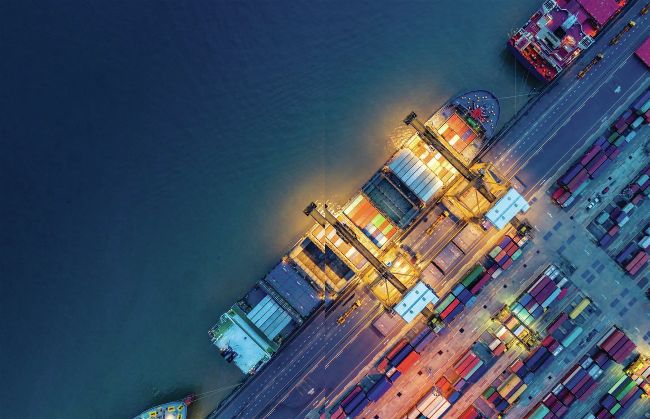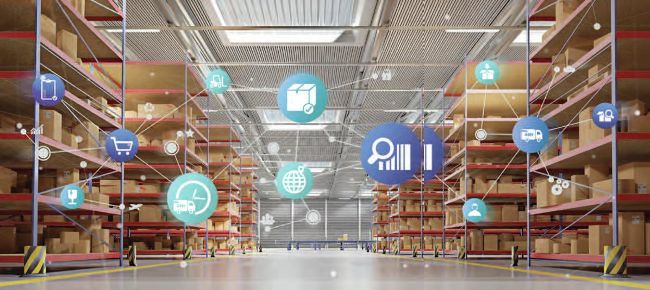MAINTAINING SUPPLY
The events of the last few years have significantly impacted supply chains. Catrin Jones looks at how companies are mitigating disruption and building resilience for the future
Over the past two years the Covid-19 pandemic, the Ukraine-Russia conflict and the energy crises have all wreaked havoc on supply chains. These challenges are impacting a large proportion of the industry.
At Bauma Munich many OEMS said that the lead time for customers after they ordered was around a year, with supply chain issues being a major contributing factor to this wait time. To combat these issues, many are finding new ways to become resilient to future problems and developing strategies that are less reliant on extensive global supply chains.
A study by consultancy Roland Berger and Off-Highway Research highlights the issues the industry is facing regarding supply chain disruption and materials shortages. The report says supply-demand imbalances, shifting material and supplier dependencies, technology innovations, labour shortages and logistics bottlenecks have contributed to increased material scarcity in recent years.
Additionally, as inflationary pressures continue and central banks in different regions take different approaches to address them, supply chain uncertainty is likely to persist.
The pressure on global supply chains has never been greater or more complex. This has led to severe disruptions and, as a result, supply chain management is undergoing a radical shift, from a delivery function to a key differentiator, says the report.
Planning and investment
Despite the challenges, Chris Jeong, CEO and managing director of Doosan Infracore Europe, remains positive. “The situation is the same for everybody, however, we are trying to optimise our supply and our supply chain management to improve our productivity.”
Jeong says that this has encouraged them to improve their forecast accuracy and plan accordingly to be able to meet customer demand.
“In the past years, it has been beneficial to improve our planning and to further invest in it. I suppose that this situation has gone on for so long that it has, in some ways, helped with advanced planning for the future.”
Other companies also share the same sentiments. For example, managing supply chains has been one of mining and infrastructure equipment manufacturer Epiroc’s main priorities since Covid-19 started.
Helena Hedblom, president and CEO of Epiroc, says that it has been a tremendous amount of extra work to ensure they can get products to customers in a timely manner.
“We have prioritised the aftermarket during the last two and a half years when we have had a shortage of components. Of course, it has been a very unpredictable situation, both on the inbound as well as on the outbound side.”
Whilst managing supply chains has not been easy for anyone in the industry, Hedblom says that planning and ordering components in advance have been vital to ensure they can meet demand.
“We have continued to execute and improve our supply chain efficiency and predictability long term,” she adds. “It has really enabled us to keep going and deliver in a good way to our customers so that we have been able to keep our promises, even though there has been a lot of unpredictability in the supply chain.”

Helena Hedblom, CEO of Epiroc
PHOTO: EPIROC
Tariffs & transportation
Andrea S. Patrucco, assistant professor of supply chain management at Florida International University, US, says the construction sector has been particularly affected because of trade tariffs and congested transportation routes that required a redesign of logistics activities and labour shortages.
Supply chain expert Andrea S Patrucco says that some building materials are now in a 'permanent' suppply shortage
“There were two big issues that contributed and are contributing to changing the industry and how supply chains are organised,” says Patrucco.
“On one side, there is the fact that several building materials are now in a permanent supply shortage. Covid-19 and the diffused lockdowns and production stoppages caused unprecedented delays in industries traditionally used to produce ‘on forecast’ and in an anticipated way (e.g., metal products and parts, lumber etc).
“These companies and supply chains are typically slow to react to sudden changes, and they still have not caught up on back-ordered production volumes. So, like any other industry, construction is facing supply chain challenges related to the production of these materials and receiving them on time for projects.”
Patrucco adds that many commodity materials have seen significant price spikes, which not only increases the final project price but also affects the supply chain’s ability to provide ontime delivery, which is usually expected when a project is overpaid.

The construction sector is particularly affected by trade tariffs and congested transportation
routes
PHOTO: ADOBE STOCK
Material prices have been going up rapidly – according to statistics released by the Associated General Contractors of America, the producer price index for lumber has seen an increase of 90% in the last two years, steel is up 128% year-over-year, copper by 71%, and aluminium is 61% more expensive. Overall, this resulted in an average 26% increase in input costs on construction projects in 2021 and 2022.
Increasing inflation
Inflation has been rising in most parts of the world, with the US seeing a sharp rise in inflation in September. This impacts the cost of materials, as well as rising other costs (such as transportation) for supply chains.
It has been beneficial to improve our planning and to further invest in it
NEW GLOBAL LOGISTICS DEAL FOR JCB
JCB has announced the appointment of a new global lead logistics provider with the awarding of a multi-million-pound fiveyear contract.
The agreement will see Denmarkbased Maersk Logistics become JCB’s lead logistics provider. The contract to manage the company’s global supply chain operations will commence in early 2023 and will see Maersk collaborate with Unipart Logistics in its delivery.
Under the new agreement, both Maersk and Unipart Logistics will play a critical role in keeping JCB’s ten UK production facilities supplied with parts from the JCB World Logistics Centre.
Gary Jeffreys, managing director at Maersk UK and Ireland, said, “We are privileged that Maersk has been selected to be the global lead logistics partner for JCB.
“Our collective strengths and experience will deliver an agile, efficient, and sustainable global supply chain for JCB.”

The pressure on global supply chains has never been greater or more
complex
PHOTO: ADOBE STOCK
Commenting on the data, Oliver Chapman, CEO of supply chain specialists OCI, says, “What is especially disappointing about the latest data on US inflation is that it surged to 8.2% in September despite energy prices falling 2.1% on the month before.”
With US core inflation hitting a 40-year high, the latest data is gloomy indeed, but Chapman says there are reasons to expect US inflation to fall sharply.
“It takes time for the supply chain to adjust to one-off shocks, but there are indications this is happening. Lumber, oil, gas, copper, iron and DRAM are among the commodities to see sharp falls in recent weeks.
“Unfortunately, supply-side adjustments are not the only reason to expect inflation to fall next year. Rising interest rates at a time of high private-sector debts will lead to a contraction in demand. This contraction will help reduce inflation but may create a recession.”
To reduce the risks of shortages, Patrucco suggests thinking about alternative materials. These might be more expensive, but it could mean the difference between a project finishing on time or not at all. “Some construction companies are looking for replacements and new sources for everything from wood panelling to ceiling joists to pipes,” he says.

Oliver Chapman, CEO of OCI
PHOTO: OCI
“Potentially higher costs and the added complications to the design and construction with these materials are more convenient than putting a project on hold for months.”
New ways of meeting demand
With supply chains disrupted, companies are searching for new ways to ensure that the impact is minimal.
“Many construction companies heavily rely on basic materials, like speciality products, tiles, flooring, and more, that are sourced from global manufacturers,” says Patrucco.
“While today these materials are more at risk of being delayed or unavailable, these global companies are still the most dependable and price-convenient ones. Shifting toward regionally based suppliers could create an even higher demand shock with similar issues and even higher prices.”
GREENING THE SUPPLY CHAIN
Balfour Beatty has partnered with the Supply Chain Sustainability School to undertake a joint survey targeting supply chain partners to understand the barriers and opportunities faced in decarbonising the sector.
The company has set out its findings and recommendations in its latest thought paper, Greening the Supply Chain. The survey found that 68% of respondents believe that the sector is not well enough prepared, 53% say that the development pipeline for low-carbon materials is not sufficient to meet demand and 81% say construction practices are changing too slowly. The paper highlights the importance of bringing in supply chain partners earlier to put in place the best, low-carbon solutions.
Jo Gilroy, group director of sustainability, Balfour Beatty, said, “With approximately 80% of the sector’s carbon emissions stemming from our supply chain, it is becoming increasingly important to understand the barriers our partners face and where they need more support.”
Patrucco suggests that many companies will adopt more of a so-called ‘global-local dual-sourcing strategy’ to buy such materials – where they purchase the biggest portion of the demand from a global manufacturer, but identify a local supplier as a backup in case of disruption to the main source of supply. This, although not cost-efficient, can avoid supply disruption.
Increased collaboration between all stakeholders in a project can also play a part in helping to overcome the current supply chain challenges.
“It is more important than ever to think about alternative delivery approaches that encourage early participation of contractors, subcontractors, and major suppliers on board during the design and engineering phase to collaboratively produce alternative solutions and shared risk management plans,” adds Patrucco.
“This way, decisions on alternative materials and inventory management policies can be addressed early on, and implementation can be carried out smoothly, ending in a more timely and higher-quality construction project.”
OCI’s Chapman proposes that an important step in transforming the supply chain lies with the supply chain audit. He adds that risk can be more effectively managed by thoroughly understanding the complex interaction of various organisations and individuals that make up the supply chain.
“A supply chain audit looks at the entire ecosystem – not just direct suppliers, but at suppliers to suppliers to suppliers,” says Chapman. “By auditing the supply chain, it is possible to get a muchimproved feel for potential weaknesses and vulnerabilities, creating opportunities to make the supply chain more robust.”

Doosan Infracore Europe says advanced planning is crucial to help mitigate supply chain issues
Potential of emerging technology
Increasing the use of technology in construction supply chains could be a positive driver for better management. Digitalisation has been a slow burner for the construction industry, but Covid-19 has accelerated adoption. One technology that could help is Building Information Modelling technologies (BIM).
BIM uses 3D and even 5D models that engage all project stakeholders to work together on project design. This way, architects, contractors, and engineers can collaborate using the same computer model and database and fine-tune the construction process.
Automated supply chain management systems can optimise workflows and streamline supply chain processes without human involvement. They can detect industry trends and highlight market data that can be used to define the most efficient and cost-effective solutions.
Another form of technology that could be used to mitigate the impact of supply chain issues is the rise of The Internet of Things (IoT). This has become a significant part of modernday life by connecting us via the internet to multiple devices; it is possible that IoT can help companies track and monitor their materials across the supply chain, on a national or global scale, and help decision-makers stay on top of their whereabouts.
Supply chain issues are a serious problem for construction and will likely remain so for some time. However, construction companies are doing what they can to re-evaluate their systems and processes to mitigate future challenges. The emergence of new solutions for better supply chain management is also encouraging as the industry develops new ways of working and overcoming what has been, and continues to be, challenging conditions.
IC